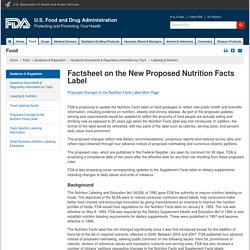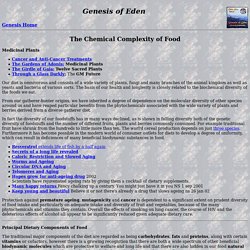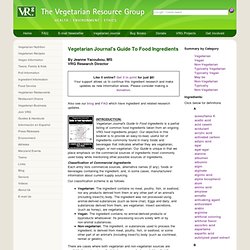

Food Facts. Food Safety. New Health Concerns. Labeling & Nutrition > Proposed Changes to the Nutrition Facts Label. En Español The FDA is proposing to update the Nutrition Facts label found on most food packages in the United States.

The Nutrition Facts label, introduced 20 years ago, helps consumers make informed food choices and maintain healthy dietary practices. If adopted, the proposed changes would include the following. Greater Understanding of Nutrition ScienceUpdated Serving Size Requirements and New Labeling Requirements for Certain Package SizesRefreshed Design Explaining the Proposed Changes Proposed Nutrition Facts Label At-A-Glance The FDA is proposing to update the Nutrition Facts label found on most food packages in the United States. 1. Require information about “added sugars.” 2. Change the serving size requirements to reflect how people eat and drink today, which has changed since serving sizes were first established 20 years ago. Labeling & Nutrition > Factsheet on the New Proposed Nutrition Facts Label. Proposed Changes to the Nutrition Facts Label Main Page FDA is proposing to update the Nutrition Facts label on food packages to reflect new public health and scientific information, including evidence on nutrition, obesity and chronic disease.

As part of the proposed updates, serving size requirements would be updated to reflect the amounts of food people are actually eating and drinking now as opposed to 20 years ago when the Nutrition Facts label was first introduced. In addition, the format of the label would be refreshed, with key parts of the label such as calories, serving sizes, and percent daily value more prominent. The proposed changes reflect new dietary recommendations, consensus reports and national survey data and reflect input obtained through four advance notices of proposed rulemaking and numerous citizens’ petitions.
The proposed rules, which are published in the Federal Register, are open for comment for 90 days. Background back to top. Nutritional Quality of Organic Versus Conventional Fruits, Vegetables, and Grains. "Prior to the widespread use of pesticides, those in the health care community who advocated organic foods claimed that these foods contained a better arrangement of nutrients as a result of the superior soil management and fertilizer practices used by organic farmers.

As a corollary, they cautioned that food grown with chemical fertilizers caused deleterious health in animals and humans. "* In NOHA* we have been concerned for many years about the deleterious health effects from residues of pesticides on foods, or even just ingested in our water. For example in NOHA NEWS, Summer 1999, we reported on the research of Professor Warren P. In her research,* Dr. She considers 35 vitamins and minerals, nitrate content, and sometimes total mineral content when that is all that is available, plus protein quantity and quality. For "conventional values" she uses the overall nutrient composition data for food from the U. Note that three of these bars would go way beyond the 90% increase! Dr. The Chemical Complexity of Food. Genesis of Eden The Chemical Complexity of Food Medicinal Plants Our diet is omnivorous and consists of a wide variety of plants, fungi and many branches of the animal kingdom as well as yeasts and bacteria of various sorts.

The basis of our health and longlevity is closely related to the biochemical diversity of the foods we eat. From our gatherer-hunter origins, we have inherited a degree of dependence on the molecular diversity of other species around us and have reaped particular benefits from the phytochemicals associated with the wide variety of plants and berries derived from a diverse gatherer diet. Nutrient Data Products and Services. Undressing The Food We Eat. CFR - Code of Federal Regulations Title 21.
(a)Relationship between diets that are low in saturated fat and cholesterol and that include soluble fiber from certain foods and the risk of CHD. (1) Cardiovascular disease means diseases of the heart and circulatory system.

Coronary heart disease (CHD) is one of the most common and serious forms of cardiovascular disease and refers to diseases of the heart muscle and supporting blood vessels. High blood total cholesterol and low density lipoprotein (LDL)-cholesterol levels are associated with increased risk of developing coronary heart disease. High CHD rates occur among people with high total cholesterol levels of 240 milligrams per deciliter (mg/dL) (6.21 (mmol/L)) or above and LDL-cholesterol levels of 160 mg/dL (4.13 mmol/L) or above. Borderline high risk total cholesterol levels range from 200 to 239 mg/dL (5.17 to 6.18 mmol/L) and 130 to 159 mg/dL (3.36 to 4.11 mmol/L) of LDL-cholesterol. (c)Requirements. (1) All requirements set forth in 101.14 shall be met. Vegetarian Resource Group. By Jeanne Yacoubou, MS VRG Research Director Like it online?

Get it in print for just $6! Your support allows us to continue this ingredient research and make updates as new information arises. Please consider making a donation. Also see our blog and FAQ which have ingredient and related research updates. INTRODUCTION:Vegetarian Journal's Guide to Food Ingredients is a partial listing of common food ingredients taken from an ongoing VRG food ingredients project. Classification of Commercial Ingredients Each entry lists commercial sources, alternative names (if any), foods or beverages containing the ingredient, and, in some cases, manufacturers' information about current supply sourcing. Our classification scheme is as follows: Vegetarian: The ingredient contains no meat, poultry, fish, or seafood, nor any products derived from them or any other part of an animal's (including insect's) body.
Note: Some manufacturers may produce non-vegan foods on equipment used to produce vegan foods. Top. Community, Food and Agriculture Book/Film Database.